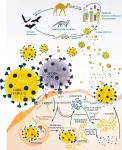(Press-News.org) Antibiotics are not necessary for patients after most routine endoscopic sinus surgeries despite the common practice to prescribe them, according to a team led by researchers at Massachusetts Eye and Ear.
In a new randomized controlled trial, patients who underwent endoscopic sinus surgery had no differences in outcomes including symptoms and infections whether they took an antibiotic or placebo after surgery. The only reported difference in outcomes was in side effects, with patients in the antibiotic group 10 times more likely to report symptoms like diarrhea.
The trial's findings were published December 19 in IFAR: International Forum of Allergy & Rhinology.
"For routine sinus surgery, antibiotics are unnecessary and may cause more complications like gastrointestinal side effects" said study co-senior author Eric H. Holbrook, MD, director of the Division of Rhinology at Mass Eye and Ear and Associate Professor of Otolaryngology-Head and Neck Surgery at Harvard Medical School. "There have been studies that have suggested antibiotics might help or maybe they don't, and we sought to clear that up through a rigorous randomized trial."
Randomized trial compared antibiotics and placebo
The researchers embarked on a randomized placebo-controlled trial in 2013 when they started enrolling patients at Mass Eye and Ear undergoing uncomplicated endoscopic sinus surgery. Patients without evidence of active infection during surgery were randomized to receive either a one-week regimen of an antibiotic or placebo afterwards.
A total of 77 patients (out of 134 enrolled) who met the study criteria were included in the final analysis: 37 received antibiotics and 40 did not. Patients were examined one week and six weeks after surgery.
Patients in both groups reported improvements in sinus symptoms after surgery, however there were no statistically significant differences reported in rates of infection nasal symptoms between the two groups. More than 24 percent of patients in the antibiotic group reported diarrhea compared to 2.5 percent in the placebo group.
While previous studies have looked at this issue of the utility of antibiotics after sinus surgery, there had been minimal, mixed data. This is the first study to have utilized a randomized trial to assess antibiotics on a one-week treatment duration on well-validated patient outcomes.
"Our findings suggest that otolaryngologists can rethink the practice of routinely prescribing antibiotics after endoscopic sinus surgery," said study co-senior author Stacey T. Gray, MD, director of the Sinus Center at Mass Eye and Ear and an Associate Professor of Otolaryngology-Head and Neck Surgery at Harvard Medical School. "Antibiotics should still be considered when the benefits outweigh the risks, including complex surgical procedures are performed or if the patient is at greater risk for developing an infection."
Antibiotics often prescribed after sinus surgery without evidence
More than 250,000 sinus surgeries occur each year for treating chronic sinus infections that don't respond to other medical treatment. In endoscopic sinus surgery, a scope and surgical tools are inserted into the nose to widen or open the normal drainage pathways that connect the sinuses to the nasal cavity. For people with chronic or recurrent infections, those openings can be too swollen for proper drainage.
It has long been debated whether antibiotics are routinely needed immediately after endoscopic sinus surgery to reduce risk of postoperative infections and decrease swelling, and optimize patient outcomes. A majority of sinus surgeons surveyed in previous studies reported giving antibiotics post-operatively.
Antibiotic resistance has been a long-cited concern throughout health care, especially when treating sinus infections. Unnecessary antibiotic prescriptions can also increase health care costs and impact quality of life due to related side effects.
This study only looked at routine endoscopic sinus surgery and not those that use dissolvable nasal packing, which can be a future area of study.
INFORMATION:
Co-authors in addition to Drs. Holbrook and Gray include Ashton E. Lehmann, MD, Aaishah R. Raquib, MS, Shan H. Siddiqi, MD, Josh Meier MD, and Marlene L. Durand MD, director of Infectious Diseases at Mass Eye and Ear.
About Mass Eye and Ear
Massachusetts Eye and Ear, founded in 1824, is an international center for treatment and research and a teaching hospital of Harvard Medical School. A member of Mass General Brigham, Mass Eye and Ear specializes in ophthalmology (eye care) and otolaryngology-head and neck surgery (ear, nose and throat care). Mass Eye and Ear clinicians provide care ranging from the routine to the very complex. Also home to the world's largest community of hearing and vision researchers, Mass Eye and Ear scientists are driven by a mission to discover the basic biology underlying conditions affecting the eyes, ears, nose, throat, head and neck and to develop new treatments and cures. In the 2020-2021 "Best Hospitals Survey," U.S. News & World Report ranked Mass Eye and Ear #4 in the nation for eye care and #6 for ear, nose and throat care. For more information about life-changing care and research at Mass Eye and Ear, visit our blog, Focus, and follow us on Instagram, Twitter and Facebook.
WEST LAFAYETTE, Ind. - A novel form of a drug used to treat osteoporosis that comes with the potential for fewer side effects may provide a new option for patients.
The work is supported by the National Institutes of Health and is published in Biophysical Journal.
Purdue University innovators developed a stabilized form of human calcitonin, which is a peptide drug already used for people with osteoporosis. Researchers at Purdue created a prodrug form of the peptide hormone to increase its effectiveness as an osteoporosis treatment.
In humans, calcitonin is the hormone responsible for normal calcium homeostasis. When prescribed to osteoporosis patients, calcitonin inhibits bone resorption, ...
Researchers at Scripps Institution of Oceanography and Skaggs School of Pharmacy and Pharmaceutical Sciences at the University of California San Diego have broken down the genomic and life history traits of three classes of viruses that have caused endemic and global pandemics in the past and identify natural products - compounds produced in nature - with the potential to disrupt their spread.
In a review appearing in the Journal of Natural Products, marine chemists Mitchell Christy, Yoshinori Uekusa, and William Gerwick, and immunologist Lena Gerwick describe the basic biology of three families of RNA viruses and how they infect human cells. These viruses use RNA instead of DNA to store their ...
BUFFALO, N.Y. - The human body is filled with friendly bacteria. However, some of these microorganisms, such as Veillonella parvula, may be too nice. These peaceful bacteria engage in a one-sided relationship with pathogen Porphyromonas gingivalis, helping the germ multiply and cause gum disease, according to a new University at Buffalo-led study.
The research sought to understand how P. gingivalis colonizes the mouth. The pathogen is unable to produce its own growth molecules until it achieves a large population in the oral microbiome (the community of microorganisms ...
The human papillomavirus infection, or HPV, is the most common sexually transmitted infection in the U.S., according to the Centers for Disease Control and Prevention. HPV is associated with health problems including genital warts and cancers, but a vaccine has been available since 2006 to help stop the virus. The CDC reports more than 12 years of data supports the HPV vaccine is safe and effective, yet HPV vaccination rates across the U.S. still remain low.
Social media has a history of being a popular place for sexual health discussions, and the HPV vaccine is one of the most discussed vaccines on the internet. Monique Luisi, an assistant professor in the University of Missouri School of Journalism, has studied more than 6,500 public HPV vaccine-related posts ...
While humanity is facing the COVID-19 pandemic, the citrus industry is trying to manage its own devastating disease, Huanglongbing (HLB), also known as citrus greening disease. HLB is the most destructive citrus disease in the world. In the past decade, the disease has annihilated the Florida citrus industry, reducing orange production for juice and other products by 72%. Candidatus Liberibacter asiaticus (CLas) is the microbe associated with the disease. It resides in the phloem of the tree and, like many plant pathogens, is transmitted by insects during feeding events. Disease progression can be slow but catastrophic. Symptoms begin with blotchy leaves, yellow shoots, and stunting, ...
BOSTON -- Getting control of COVID-19 will take more than widespread vaccination; it will also require better understanding of why the disease causes no apparent symptoms in some people but leads to rapid multi-organ failure and death in others, as well as better insight into what treatments work best and for which patients.
To meet this unprecedented challenge, researchers at Massachusetts General Hospital (MGH), in collaboration with investigators from Brigham and Women's Hospital and the University of Cyprus, have created a mathematical model based on biology that incorporates information ...
Diabetes continues to be the leading cause of new cases of blindness among adults in the United States. But the current shortage of eye-care providers would make it impossible to keep up with demand to provide the requisite annual screenings for this population. A new study looks at the effectiveness of seven artificial intelligence-based screening algorithms to diagnose diabetic retinopathy, the most common diabetic eye disease leading to vision loss.
In a paper published Jan. 5 in Diabetes Care, researchers compared the algorithms against the diagnostic expertise of retina specialists. Five companies produced the tested algorithms - two in the United States (Eyenuk, Retina-AI Health), one in China (Airdoc), one in Portugal (Retmarker), ...
Fishermen contend with regulations, natural disasters, and the ups and downs of the stocks they fish, along with many other changes. As a result, fishing communities are quite resilient. That is, they can withstand, recover from, and adapt to change.
But how much pressure can they stand? The 2014-2016 North Pacific marine heatwave, known as the Blob, led to a harmful algal bloom of unprecedented scale. It necessitated substantial delays in the opening of the 2015-16 U.S. West Coast Dungeness crab fishery. The fishery is vital to West Coast communities. It produces around 26 percent of all annual fishing revenue and supports more than 30 percent of all commercial fishing vessels.
Understanding ...
Humans have consumed different types of fermented foods - from kimchi to yogurt - for thousands of years. Yet only recently, with the availability of new scientific techniques for analyzing their nutritional properties and microbiological composition, have scientists begun to understand exactly how the unique flavors and textures are created and how these foods benefit human health.
Now, 13 interdisciplinary scientists from the fields of microbiology, food science and technology, family medicine, ecology, immunology, and microbial genetics have come together to create the first international consensus definition of fermented ...
Hotel managers have something in common beyond their reputations for charming dispositions and excellent listening skills - they're predominantly men, despite women making up the majority of the accommodations workforce. New research led by the University of Houston Conrad N. Hilton College of Hotel and Restaurant Management suggests hotel companies that promote a woman over an equally qualified man are perceived as fairer and less discriminatory, creating a stronger organizational culture and higher financial performance.
Published in the International Journal of Contemporary Hospitality Management, the study is the first to address gender inequity in promotional opportunities for hotel employees. The researchers surveyed 87 hotel ...





